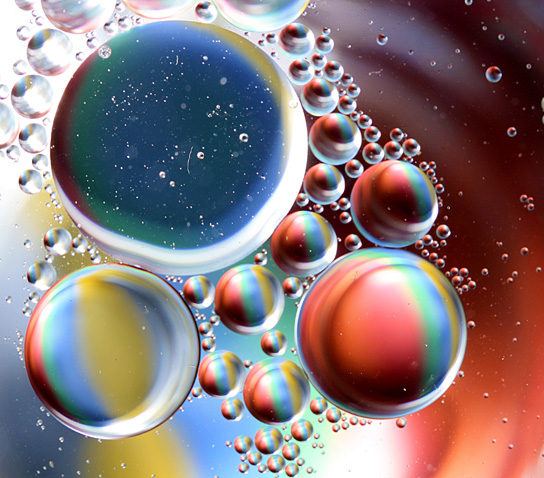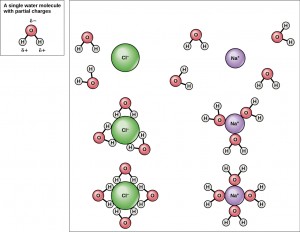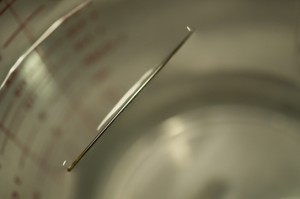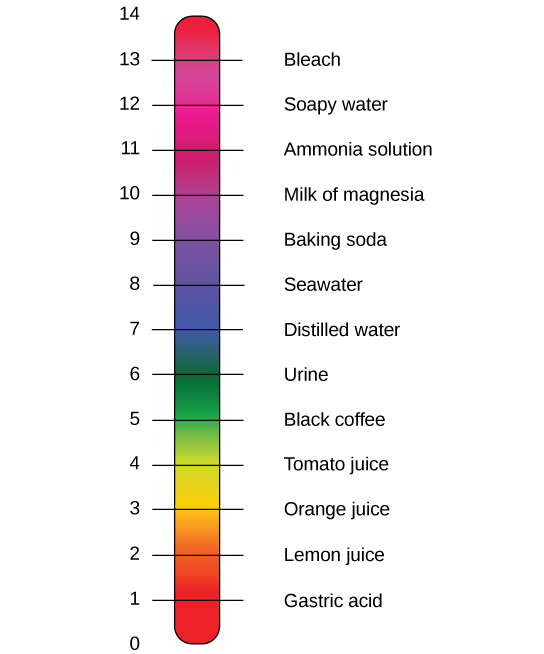Which Image Best Represents An Animal Exhibiting Kinetic Energy?
Chapter 2: Introduction to the Chemistry of Life
ii.2 Water
By the terminate of this section, you will exist able to:
- Describe the properties of water that are critical to maintaining life
Watch a video about why nosotros need oxygen and how it causes problems for living things.
Do you e'er wonder why scientists spend fourth dimension looking for water on other planets? It is because water is essential to life; even minute traces of it on another planet tin can indicate that life could or did exist on that planet. Water is ane of the more arable molecules in living cells and the one nearly critical to life as we know it. Approximately 60–70 percent of your body is fabricated up of water. Without it, life simply would not be.
Water Is Polar
The hydrogen and oxygen atoms inside water molecules form polar covalent bonds. The shared electrons spend more than time associated with the oxygen atom than they do with hydrogen atoms. There is no overall charge to a water molecule, just there is a slight positive charge on each hydrogen atom and a slight negative charge on the oxygen atom. Because of these charges, the slightly positive hydrogen atoms repel each other and course the unique shape. Each water molecule attracts other water molecules because of the positive and negative charges in the different parts of the molecule. Water also attracts other polar molecules (such as sugars), forming hydrogen bonds. When a substance readily forms hydrogen bonds with h2o, it tin dissolve in h2o and is referred to as hydrophilic ("water-loving"). Hydrogen bonds are not readily formed with nonpolar substances like oils and fats . These nonpolar compounds are hydrophobic ("water-fearing") and will not deliquesce in water.

H2o Stabilizes Temperature
The hydrogen bonds in water allow it to absorb and release heat energy more slowly than many other substances. Temperature is a measure out of the motion (kinetic energy) of molecules. As the motion increases, energy is higher and thus temperature is college. H2o absorbs a great deal of energy before its temperature rises. Increased energy disrupts the hydrogen bonds between water molecules. Because these bonds tin be created and disrupted rapidly, water absorbs an increase in energy and temperature changes but minimally. This ways that water moderates temperature changes within organisms and in their environments. Every bit energy input continues, the residual between hydrogen-bail formation and devastation swings toward the destruction side. More bonds are cleaved than are formed. This process results in the release of private water molecules at the surface of the liquid (such as a body of water, the leaves of a plant, or the skin of an organism) in a process called evaporation. Evaporation of sweat, which is ninety percent water, allows for cooling of an organism, because breaking hydrogen bonds requires an input of free energy and takes heat away from the torso.
Conversely, as molecular movement decreases and temperatures drop, less energy is present to break the hydrogen bonds betwixt water molecules. These bonds remain intact and begin to form a rigid, lattice-similar construction (eastward.thou., ice) (Figure 2.8 a). When frozen, ice is less dumbo than liquid water (the molecules are further apart). This means that ice floats on the surface of a body of water (Effigy ii.8 b). In lakes, ponds, and oceans, water ice volition course on the surface of the water, creating an insulating barrier to protect the animate being and plant life beneath from freezing in the h2o. If this did non happen, plants and animals living in water would freeze in a block of water ice and could non move freely, making life in cold temperatures difficult or impossible.

Water Is an First-class Solvent
Because water is polar, with slight positive and negative charges, ionic compounds and polar molecules can readily dissolve in it. H2o is, therefore, what is referred to as a solvent—a substance capable of dissolving some other substance. The charged particles will grade hydrogen bonds with a surrounding layer of h2o molecules. This is referred to equally a sphere of hydration and serves to go along the particles separated or dispersed in the water. In the case of tabular array salt (NaCl) mixed in h2o, the sodium and chloride ions split up, or dissociate, in the water, and spheres of hydration are formed around the ions. A positively charged sodium ion is surrounded by the partially negative charges of oxygen atoms in water molecules. A negatively charged chloride ion is surrounded past the partially positive charges of hydrogen atoms in h2o molecules. These spheres of hydration are as well referred to as hydration shells. The polarity of the water molecule makes it an constructive solvent and is important in its many roles in living systems.

Water Is Cohesive
Have you ever filled up a glass of h2o to the very top and then slowly added a few more drops? Earlier it overflows, the water actually forms a dome-like shape above the rim of the glass. This water can stay in a higher place the glass because of the property of cohesion. In cohesion, water molecules are attracted to each other (considering of hydrogen bonding), keeping the molecules together at the liquid-air (gas) interface, although there is no more room in the glass. Cohesion gives rise to surface tension, the capacity of a substance to withstand rupture when placed under tension or stress. When you driblet a small bit of paper onto a droplet of water, the newspaper floats on top of the water droplet, although the object is denser (heavier) than the water. This occurs because of the surface tension that is created by the water molecules. Cohesion and surface tension go on the water molecules intact and the item floating on the peak. It is even possible to "float" a steel needle on top of a glass of water if yous place information technology gently, without breaking the surface tension.

These cohesive forces are also related to the water's property of adhesion, or the allure between h2o molecules and other molecules. This is observed when water "climbs" up a straw placed in a glass of water. You lot will observe that the water appears to be college on the sides of the harbinger than in the middle. This is because the water molecules are attracted to the straw and therefore adhere to information technology.
Cohesive and agglutinative forces are important for sustaining life. For case, considering of these forces, water can flow upward from the roots to the tops of plants to feed the constitute.
Concept in Action
To larn more than about water, visit the U.S. Geological Survey Water Scientific discipline for Schools: All Nigh Water! website.
Buffers, pH, Acids, and Bases
The pH of a solution is a measure of its acerbity or alkalinity. You have probably used litmus paper, paper that has been treated with a natural water-soluble dye then it tin can be used equally a pH indicator, to exam how much acid or base (alkalinity) exists in a solution. You might take even used some to make sure the h2o in an outdoor swimming pool is properly treated. In both cases, this pH test measures the amount of hydrogen ions that exists in a given solution. High concentrations of hydrogen ions yield a depression pH, whereas low levels of hydrogen ions result in a loftier pH. The overall concentration of hydrogen ions is inversely related to its pH and can be measured on the pH scale (Figure ii.11). Therefore, the more hydrogen ions present, the lower the pH; conversely, the fewer hydrogen ions, the college the pH.
The pH scale ranges from 0 to xiv. A change of one unit on the pH calibration represents a alter in the concentration of hydrogen ions past a factor of 10, a change in two units represents a change in the concentration of hydrogen ions by a factor of 100. Thus, small changes in pH correspond large changes in the concentrations of hydrogen ions. Pure water is neutral. Information technology is neither acidic nor basic, and has a pH of seven.0. Annihilation below seven.0 (ranging from 0.0 to 6.9) is acidic, and anything to a higher place 7.0 (from seven.ane to 14.0) is alkali metal. The blood in your veins is slightly element of group i (pH = 7.4). The environment in your tum is highly acidic (pH = 1 to 2). Orange juice is mildly acidic (pH = approximately 3.five), whereas baking soda is basic (pH = nine.0).

Acids are substances that provide hydrogen ions (H+) and lower pH, whereas bases provide hydroxide ions (OH–) and enhance pH. The stronger the acrid, the more readily it donates H+. For instance, hydrochloric acid and lemon juice are very acidic and readily give up H+ when added to water. Conversely, bases are those substances that readily donate OH–. The OH– ions combine with H+ to produce water, which raises a substance'southward pH. Sodium hydroxide and many household cleaners are very element of group i and surrender OH– apace when placed in h2o, thereby raising the pH.
Most cells in our bodies operate within a very narrow window of the pH scale, typically ranging just from seven.2 to 7.6. If the pH of the body is outside of this range, the respiratory system malfunctions, as practise other organs in the body. Cells no longer office properly, and proteins volition break downwards. Difference exterior of the pH range can induce coma or even cause death.
And then how is information technology that we can ingest or inhale acidic or basic substances and not die? Buffers are the key. Buffers readily absorb excess H+ or OH–, keeping the pH of the body carefully maintained in the aforementioned narrow range. Carbon dioxide is function of a prominent buffer system in the homo torso; it keeps the pH inside the proper range. This buffer organization involves carbonic acrid (HiiCOthree) and bicarbonate (HCOiii –) anion. If too much H+ enters the body, bicarbonate volition combine with the H+ to create carbonic acrid and limit the decrease in pH. Likewise, if too much OH– is introduced into the system, carbonic acid volition chop-chop dissociate into bicarbonate and H+ ions. The H+ ions tin combine with the OH– ions, limiting the increase in pH. While carbonic acid is an of import production in this reaction, its presence is fleeting because the carbonic acid is released from the torso as carbon dioxide gas each time nosotros breathe. Without this buffer system, the pH in our bodies would fluctuate also much and nosotros would fail to survive.
Section Summary
Water has many properties that are critical to maintaining life. It is polar, allowing for the formation of hydrogen bonds, which permit ions and other polar molecules to dissolve in water. Therefore, water is an first-class solvent. The hydrogen bonds between water molecules give water the ability to agree rut meliorate than many other substances. As the temperature rises, the hydrogen bonds between h2o continually interruption and reform, assuasive for the overall temperature to remain stable, although increased free energy is added to the organisation. Water'southward cohesive forces allow for the holding of surface tension. All of these unique properties of water are important in the chemistry of living organisms.
The pH of a solution is a measure of the concentration of hydrogen ions in the solution. A solution with a loftier number of hydrogen ions is acidic and has a low pH value. A solution with a loftier number of hydroxide ions is bones and has a high pH value. The pH scale ranges from 0 to fourteen, with a pH of 7 being neutral. Buffers are solutions that moderate pH changes when an acrid or base is added to the buffer organization. Buffers are important in biological systems considering of their ability to maintain abiding pH weather condition.
acid: a substance that donates hydrogen ions and therefore lowers pH
adhesion: the attraction between water molecules and molecules of a different substance
base: a substance that absorbs hydrogen ions and therefore raises pH
buffer: a solution that resists a alter in pH by absorbing or releasing hydrogen or hydroxide ions
cohesion: the intermolecular forces between h2o molecules caused past the polar nature of h2o; creates surface tension
evaporation: the release of water molecules from liquid water to form h2o vapor
hydrophilic: describes a substance that dissolves in water; water-loving
hydrophobic: describes a substance that does not dissolve in water; water-fearing
litmus paper: filter paper that has been treated with a natural h2o-soluble dye so information technology can be used equally a pH indicator
pH scale: a scale ranging from 0 to 14 that measures the approximate concentration of hydrogen ions of a substance
solvent: a substance capable of dissolving another substance
surface tension: the cohesive force at the surface of a torso of liquid that prevents the molecules from separating
temperature: a measure out of molecular motion
References
Humphrey, Due west., Dalke, A. and Schulten, G., "VMD—Visual Molecular Dynamics", J. Molec. Graphics, 1996, vol. 14, pp. 33-38. http://www.ks.uiuc.edu/Research/vmd/
Media Attribution
- Figure 2.7 past Gautam Dogra
- Figure two.8
- water ice lattice by Jane Whitney
- (b) past Carlos Ponte
- Effigy ii.x by Cory Zanker
- Figure 2.11 by Edward Stevens
Source: https://opentextbc.ca/biology/chapter/2-2-water/
Posted by: confernotilen.blogspot.com


0 Response to "Which Image Best Represents An Animal Exhibiting Kinetic Energy?"
Post a Comment